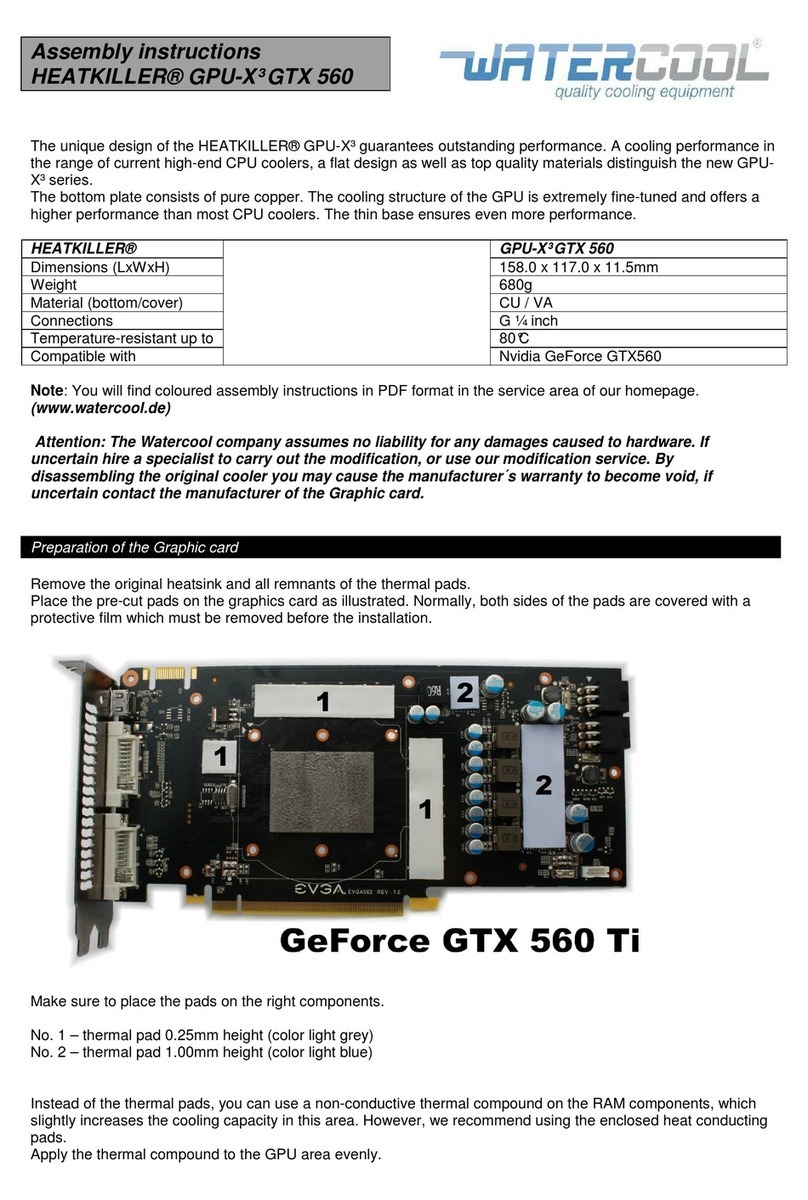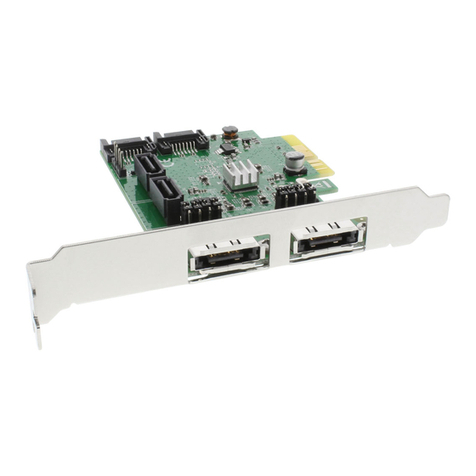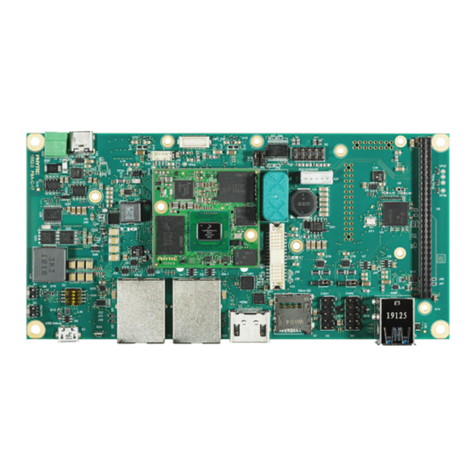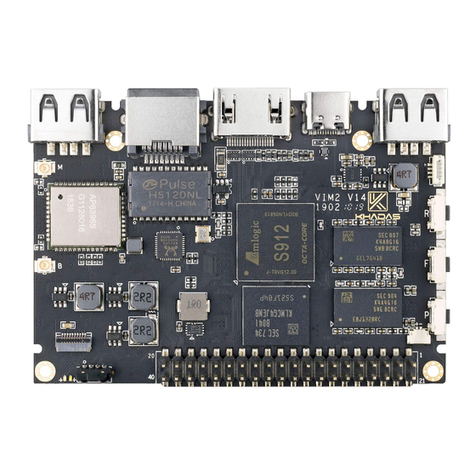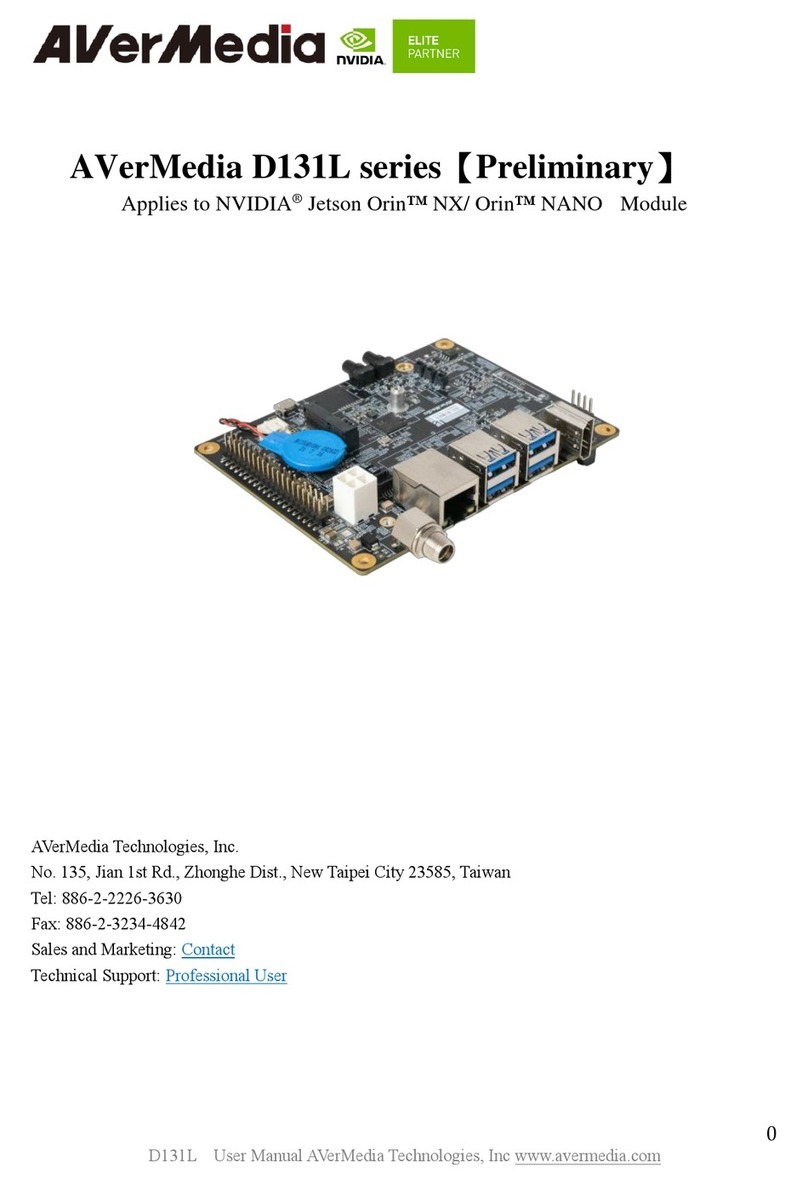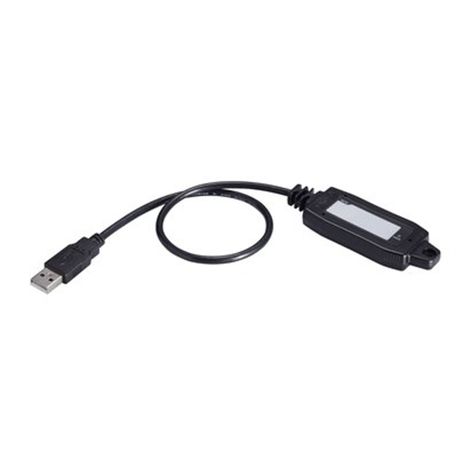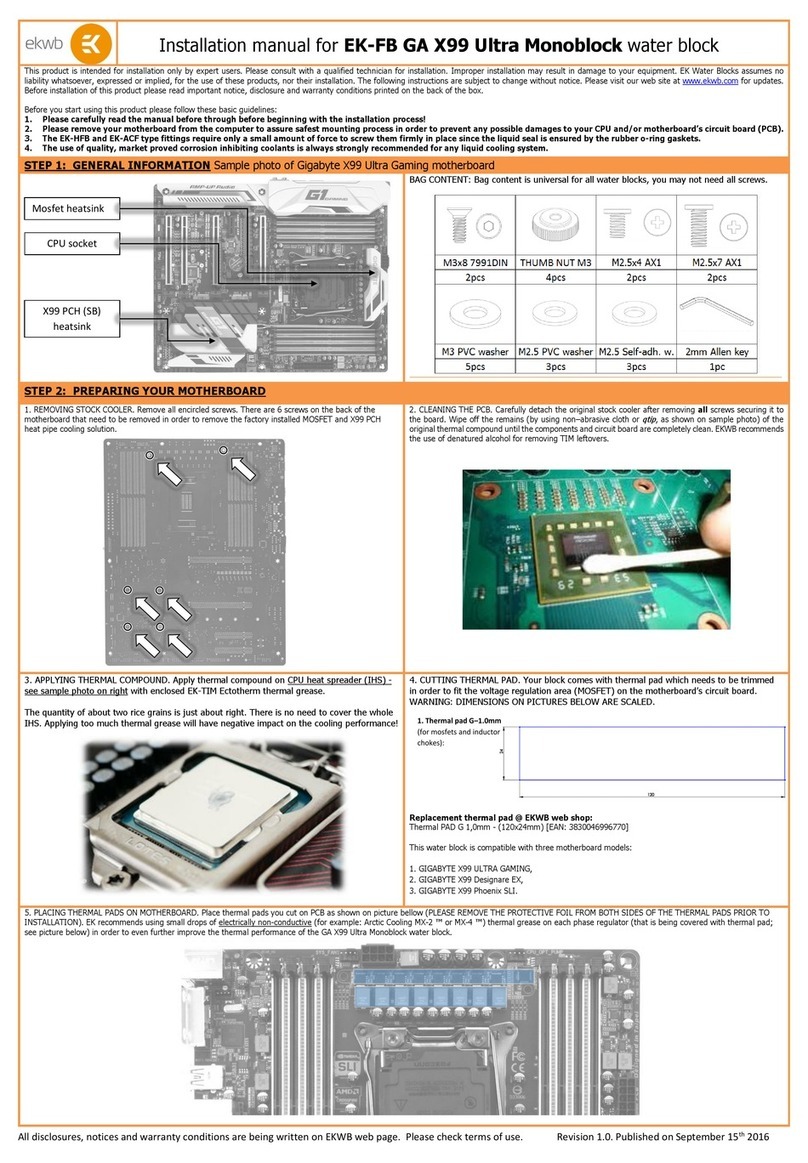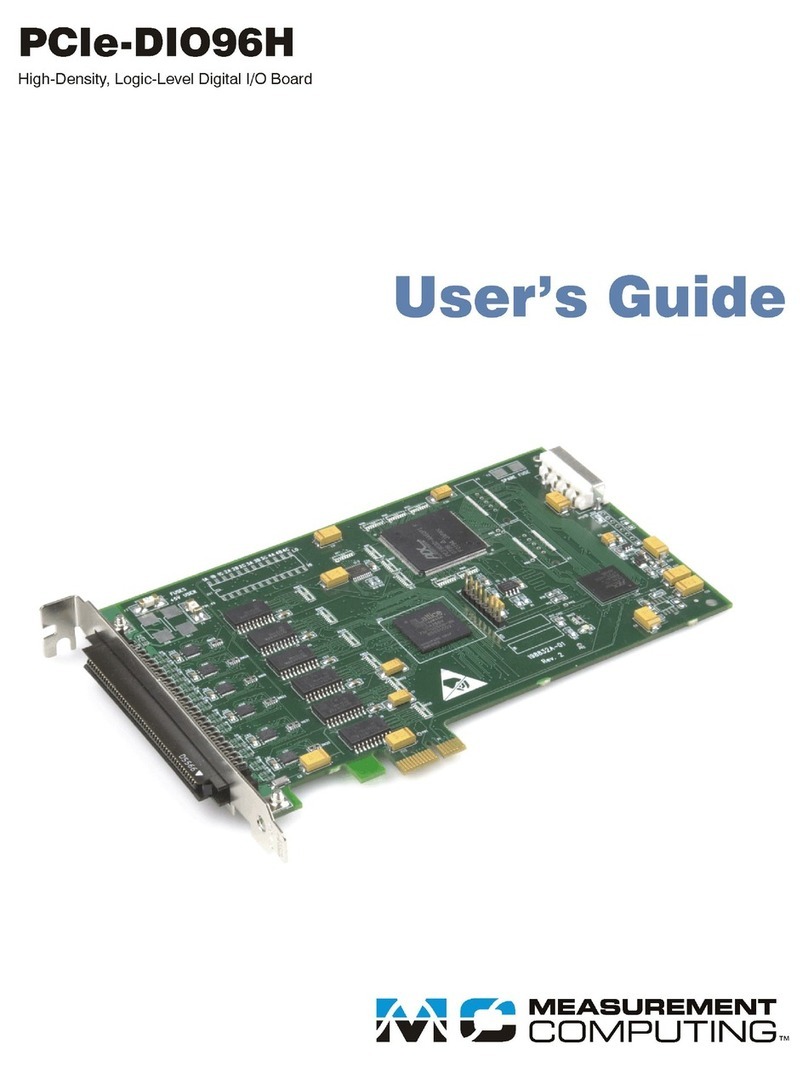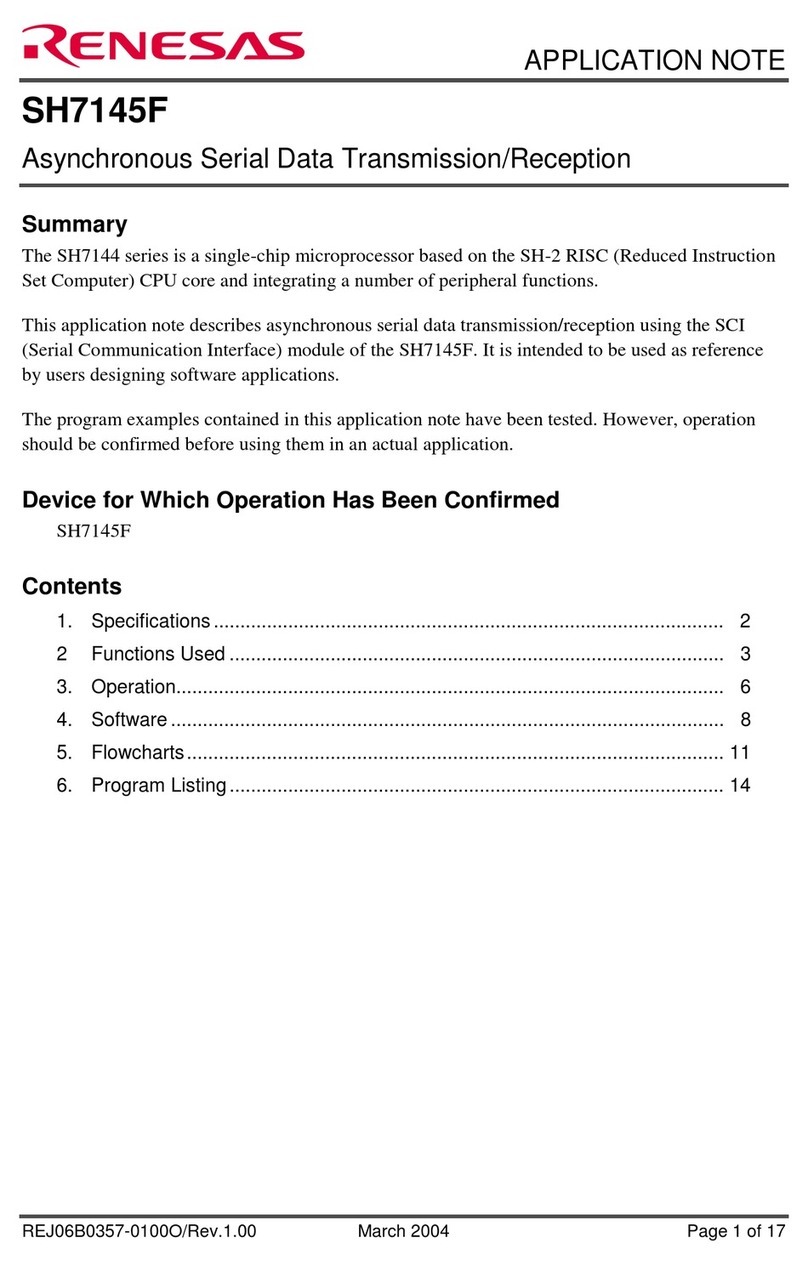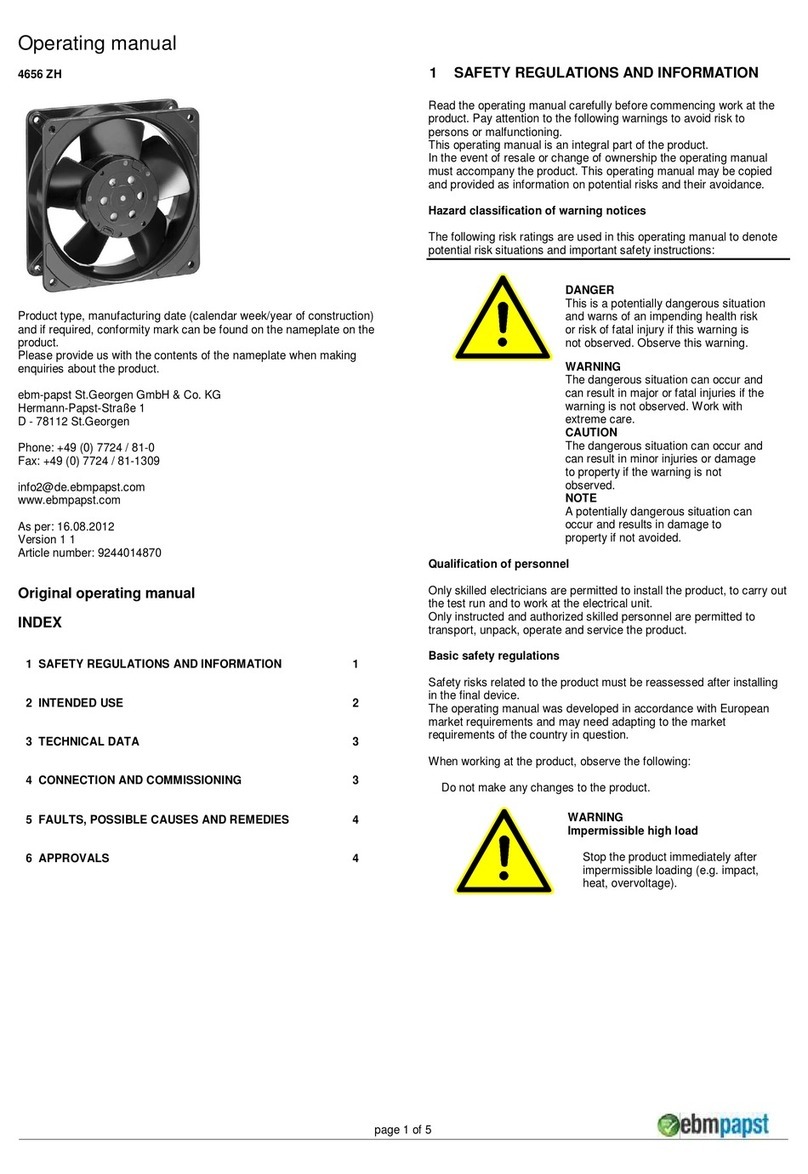MEIG SLM156 Guide

MeiG_SLM156_
Hardware Design Manual
Controlled Version Number: V1.0
Release Date: 2019/08/01

MeiG_SLM156_Hardware Design Manual
MeiG Smart Technology Co., Ltd
1/63
Important Notice
Copyright Notice
All rights reserved. MeiG Smart Technology Co., Ltd
This manual and all its contents are owned by MeiG Smart Technology Co., Ltd and protected by
Chinese laws and relevant copyright laws in applicable international conventions. Without the
written authorization of MeiG Smart Technology Co., Ltd, no one may copy, disseminate, distribute,
modify or use part or all of this manual in any form, and the offenders will be held responsible
according to law.
Statement of No Guarantee
MeiG Smart Technology Co., Ltd makes no representations or guarantees, either express or
implied, for any contents in this document, and assumes no responsibility for the merchantability
and fitness for a particular purpose or any indirect, extraordinary or consequential losses.
Confidentiality Claim
The information contained in this document (including any annexes) is confidential. The recipient
understands that the document obtained by him is confidential and shall not be used for any
purpose other than the stated purpose, and he shall not disclose this document to any third party.
Disclaimer
The company assumes no responsibility for property damage or personal injury caused by
customers' improper operation. Customers are requested to develop corresponding products
according to the technical specifications and reference designs in the manual. Before the
disclaimer, the company has the right to change the contents of this manual according to the needs
of technological development, and the version is subject to change without further notice.

MeiG_SLM156_Hardware Design Manual
MeiG Smart Technology Co., Ltd
2/63
Revision History
Version
Date
Reason for Revision
V1.0
2019-08-01
Establish for the first version

MeiG_SLM156_Hardware Design Manual
MeiG Smart Technology Co., Ltd
3/63
Contents
Important Notice....................................................................................................................................... 1
Revision History....................................................................................................................................... 2
Contents.................................................................................................................................................... 3
Table Index................................................................................................................................................ 5
Figure Index.............................................................................................................................................. 6
1Introduction........................................................................................................................................ 7
1.1 Safety Instructions.................................................................................................................... 8
1.2 Purpose of the Document........................................................................................................ 9
1.3 List of Contents........................................................................................................................ 9
2Product Overview............................................................................................................................ 10
2.1 Basic Description ................................................................................................................... 10
2.2 Main Performance.................................................................................................................. 10
2.3 Evaluation Board.................................................................................................................... 13
3Application Interface....................................................................................................................... 14
3.1 General Description ............................................................................................................... 14
3.2 Pin Definition of LCC Module................................................................................................. 15
3.3 Pin Description....................................................................................................................... 16
3.4 Operating Mode ..................................................................................................................... 21
3.5 Power Saving......................................................................................................................... 22
3.5.1 Flight Mode.................................................................................................................. 22
3.5.2 Power Saving Mode (PSM)......................................................................................... 23
3.5.3 Extent Idle Mode Discontinuous Receiving ................................................................ 23
3.6 Power Supply......................................................................................................................... 24
3.6.1 Power Supply Pins...................................................................................................... 24
3.6.2 Decrease Voltage Drop............................................................................................... 25
3.6.3 VDD_EXT Voltage Output........................................................................................... 25
3.7 Turn on and off....................................................................................................................... 26
3.7.1 Turn on Module Using the POWER_ON/OFF............................................................ 26
3.7.2 Turn off Module Using the POWER_ON/OFF Pin...................................................... 28
3.8 Reset Fuction......................................................................................................................... 28
3.8.1 AT Command Reset.................................................................................................... 28
3.9 USIM/SIM Interface................................................................................................................ 28
3.9.1 USIM/SIM Card Interface Pin Description .................................................................. 29
3.10 USB Interface......................................................................................................................... 31
3.10.1 USB Pin Description.................................................................................................... 31
3.10.2 USB Reference Circuit................................................................................................ 31
3.10.3 USB Driver .................................................................................................................. 32
3.11 UART Interface....................................................................................................................... 32
3.11.1 UART Pin Description................................................................................................. 33
3.12 Network Status Indication...................................................................................................... 34
3.13 Status Indicaiton..................................................................................................................... 35
3.14 ADC Function......................................................................................................................... 36
3.15 DLOAD Interface.................................................................................................................... 37

MeiG_SLM156_Hardware Design Manual
MeiG Smart Technology Co., Ltd
4/63
3.16 PCM Interface........................................................................................................................ 37
4GNSS Receiver ................................................................................................................................ 40
4.1 General Description ............................................................................................................... 40
4.2 GNSS Performance ............................................................................................................... 40
4.3 Layout Guideline.................................................................................................................... 41
5Antenna Interface............................................................................................................................ 42
5.1 Antenna Interface................................................................................................................... 42
5.1.1 Working Band.............................................................................................................. 42
5.2 RF Reference Circuit.............................................................................................................. 43
5.3 Antenna Installation................................................................................................................ 45
5.3.1 Antenna Requirements ............................................................................................... 45
5.3.2 Recommended RF Connector in Antenna Installation............................................... 46
6Electrical Characteristics ............................................................................................................... 48
6.1 Limit Voltage........................................................................................................................... 48
6.2 Power Rated Parameter ........................................................................................................ 48
6.3 Working Temperature............................................................................................................. 49
6.4 Electrical Characteristics of Interface Operation Status........................................................ 49
6.5 Module Power Consumption Range...................................................................................... 50
6.6 Transmission Power............................................................................................................... 51
6.7 Receiving Sensitivity.............................................................................................................. 51
6.8 Environmental Reliability Requirements................................................................................ 52
6.9 ESD Features......................................................................................................................... 53
7Mechanical Dimensions.................................................................................................................. 54
7.1 Mechanical Dimensions of the Module.................................................................................. 54
7.2 Recommended Packaging..................................................................................................... 56
7.3 Top View of the Module.......................................................................................................... 57
7.4 Bottom View of the Module.................................................................................................... 57
8Storage and Manufacturing............................................................................................................ 58
8.1 Storage................................................................................................................................... 58
8.2 Manufacturing and Welding ................................................................................................... 59
8.3 Packaging............................................................................................................................... 60
9Appendix A References and Abbreviations.................................................................................. 61
9.1 Reference............................................................................................................................... 61
9.2 Terms andAbbreviations........................................................................................................ 61

MeiG_SLM156_Hardware Design Manual
MeiG Smart Technology Co., Ltd
5/63
Table Index
Table 1 Supported bands of SLM156 and GNSS function.................................................................. 10
Table 2 List of main features of the module......................................................................................... 10
Table 3 IO parameters definition.......................................................................................................... 16
Table 4 Pin description......................................................................................................................... 16
Table 5 Overview of operating mode................................................................................................... 21
Table 6 Related power supply interfaces............................................................................................. 24
Table 7 Description of POWER_ON/OFF pin...................................................................................... 26
Table 8 USIM/SIM card interface......................................................................................................... 29
Table 9 USB interface description ....................................................................................................... 31
Table 10 UART1 pin description............................................................................................................ 33
Table 11 Pin description of debugging interface.................................................................................... 33
Table 12 Logical level of interface......................................................................................................... 33
Table 13 Pin description of network indication...................................................................................... 34
Table 14 Activity status of NET_STATUS.............................................................................................. 34
Table 15 STATUS pin definition............................................................................................................. 35
Table 16 ADC pin description................................................................................................................ 36
Table 17 DLOAD pin description........................................................................................................... 37
Table 18 Pin description of PCM interface............................................................................................ 39
Table 19 GNSS performance................................................................................................................. 40
Table 20 Pin definition of RF antenna ................................................................................................... 42
Table 21 Working band of the module................................................................................................... 42
Table 22 Antenna Requirements........................................................................................................... 45
Table 23 Limit voltage range.................................................................................................................. 48
Table 24 Power rated parameter of the module.................................................................................... 48
Table 25 Temperature range.................................................................................................................. 49
Table 26 Logical level of normal digital IO signal.................................................................................. 49
Table 27 Electrical characteristics in power supply status.................................................................... 50
Table 28 SLM156 current consumption................................................................................................. 50
Table 29 SLM156 transmission power .................................................................................................. 51
Table 30 SLM156 receiving sensitivity .................................................................................................. 51
Table 31 Environmental reliability requirements.................................................................................... 52
Table 32 ESD performance parameter (temperature: 25°C, humidity: 45%)........................................ 53
Table 33 Terms and abbreviations......................................................................................................... 61

MeiG_SLM156_Hardware Design Manual
MeiG Smart Technology Co., Ltd
6/63
Figure Index
Figure 1 Pin Assignment...................................................................................................................... 15
Figure 2 Reference Circuit for Power Supply...................................................................................... 25
Figure 3 Turn on the Module Using Driving Circuit ............................................................................. 26
Figure 4 Turn on the Module Using Keystroke.................................................................................... 26
Figure 5 Timing of Turning on Module................................................................................................. 27
Figure 6 Timing of Turning off Module................................................................................................. 28
Figure 7 Reference Circuit for 8-pin USIM/SIM Connector................................................................. 29
Figure 8 Reference Circuit for 6-pin USIM/SIM Connector................................................................. 30
Figure 9 USB Reference Circuit .......................................................................................................... 31
Figure 10 Reference Circuit of Level Conversion Chip......................................................................... 34
Figure 11 Reference Circuit of Network Indication................................................................................ 35
Figure 12 Reference Circuit of Network Indication................................................................................ 35
Figure 13 Reference Circuit of STATUS................................................................................................ 36
Figure 14 Reference Circuit of STATUS................................................................................................ 36
Figure 15 Reference Circuit of DLOAD Interface.................................................................................. 37
Figure 16 Short Frame Mode Timing..................................................................................................... 38
Figure 17 Long Frame Mode Timing..................................................................................................... 38
Figure 18 Reference Circuit of PCM ..................................................................................................... 39
Figure 19 Reference Circuit................................................................................................................... 44
Figure 20 GNSS Antenna Reference Circuit......................................................................................... 44
Figure 21 Connection Dimension of UF.L-R-SMT (unit: mm) ............................................................... 46
Figure 22 UF.L-LP Series Connecting Line........................................................................................... 47
Figure 23 Installation Dimension (unit:mm)........................................................................................... 47
Figure 24 Dimension of the Module from Top View and Side View (unit: mm)..................................... 54
Figure 25 Dimension of the module from Bottom View (unit: mm) ....................................................... 55
Figure 26 Recommended Packaging (unit: mm)................................................................................... 56
Figure 27 Top View of the Module......................................................................................................... 57
Figure 28 Bottom View of the Module................................................................................................... 57
Figure 29 Reflow Soldering Temperature Profile .................................................................................. 59
Figure 30 Pallet Packaging (Unit: mm).................................................................................................. 60

MeiG_SLM156_Hardware Design Manual
MeiG Smart Technology Co., Ltd
7/63
1 Introduction
This document defines SLM156 and describes its air interface and hardware interface which are
connected with your application.
The document can help you quickly understand SLM156 interface specifications, electrical and
mechanical details and other related product information. Associated with application notes and user
guide, you can apply SLM156 in wireless applications easily.

MeiG_SLM156_Hardware Design Manual
MeiG Smart Technology Co., Ltd
8/63
1.1 Safety Instructions
By complying with the following safety principles, you can ensure personal safety and protect the
products and working environment from potential damage:
Driving safety first! When you drive, do not use handheld mobile terminal device
unless it has a hands-free function. Please stop the car before calling!
Please turn off the mobile terminal device before boarding. The wireless function
of mobile terminal shall not be turned on in the aircraft to prevent interference
with the aircraft communication system. Ignoring this reminder may affect flying
safety or even violate the law.
In hospitals or health care facilities, pay attention to whether there are restrictions
on the use of mobile terminal device. RF interference will cause medical
equipment to be abnormal, so mobile terminal device may need to be turned off.
Mobile terminal device cannot always be effectively connected, for example, if
the mobile device has no expense or the SIM is invalid. When you encounter the
above situations in an emergency, please make an emergency call, meanwhile,
ensure that your device is turned on and in an area with sufficient signal strength.
Your mobile terminal device will receive and transmit radio frequency signals
when it is turned on. There will be radio frequency interference when it is close to
TV, radio, computer or other electronic equipment.
Please keep mobile device away from inflammable gases. Please turn off the
mobile terminal device when you are near a fueling station, oil depot, chemical
plant or explosion site. There will be potential safety hazards when operating
electronic equipment in any place with potential explosion hazard.

MeiG_SLM156_Hardware Design Manual
MeiG Smart Technology Co., Ltd
9/63
1.2 Purpose of the Document
This document describes basic functions and main features of SLM156 wireless module, as well as
hardware interface and its application, features of structure and electronics, and power index, in order
to guide you to embed SLM156 in various application terminals.
1.3 List of Contents
The document includes:
Chapter 1 introduces safety information, purpose of the document and revising records;
Chapter 2 describes basic functions and main features of SLM156 wireless module;
Chapter 3 describes functions, features, and applications of each hardware interface of SLM156;
Chapter 4 describes related features of GNSS;
Chapter 5 introduces related information and notes of antenna interface;
Chapter 6 describes electronic features of SLM156;
Chapter 7 describes structure features and notes of SLM156;
Chapter 8 describes storage and production notes of SLM156;
Chapter 9 Appendix A: Reference documents and abbreviations.

MeiG_SLM156_Hardware Design Manual
MeiG Smart Technology Co., Ltd
10/63
2 Product Overview
2.1 Basic Description
SLM156 is a multi - mode IOT wireless communication module, which supports half-duplex LTE and
does not support diversity receiving function. SLM156 can provide data connection under LTE-FDD,
GPRS and EGPRS networks, and it also supports GNSS and voice function.
The following table shows the supported bands of SLM156 and GNSS function:
Table 1 Supported bands of SLM156 and GNSS function
Module
LTE band
GSM band
Diversity
receiving
GNSS
SLM156
Cat M1 &NB1:
NB-IoT:(Class 5):
B1/B2/B3/B4/B5/B8/B12/
B13/B18/B19/B20/B25/B2
6/B28/B66/B71/B85
Cat M(Class5):
B1/B2/B3/B4/B5/B8/B12/
B13/B14/B18/B19/B20/B2
5/B26/B27/B28/B66/B85
EGPRS:
GSM850/EGSM900/D
CS1800/PCS1900
Non-
supportive
GPS, GLONASS,
BeiDou/Compass,
Galileo, QZSS
Using advanced highly integrated design, SLM156 integrates RF and baseband on a piece of PCB
which has functions of wireless reception and transmission, baseband signal processing. It uses single
side layout and the size is: 21×20×2.3 mm. The module can be applied in security system, wearable
services, wireless POS machine, industrial PDA, intelligent meter reading, wireless remote control,
vehicle devices, etc .
2.2 Main Performance
The following table describes the performance of the SLM156 in detail.
Table 2 List of main features of the module
Parameter
Description
Power supply
VBAT power supply range: 3.3V~4.2V
Typical supply voltage: 3.8V

MeiG_SLM156_Hardware Design Manual
MeiG Smart Technology Co., Ltd
11/63
Transmit power
Class 5 (20dBm±2dB) for LTE FDD bands
Class 4 (33dBm±2dB) for GSM850
Class 4 (33dBm±2dB) for GSM900
Class 1 (30dBm±2dB) for DCS1800
Class 1 (30dBm±2dB) for PCS1900
Class E2 (27dBm±3dB) for GSM850 8-PSK
Class E2 (27dBm±3dB) for GSM900 8-PSK
Class E2 (26dBm±3dB) for DCS1800 8-PSK
Class E2 (26dBm±3dB) for PCS1900 8-PSK
LTE features
Support LTE Cat.M1 and LTE Cat.NB2
LTE Cat.M1: support 1.4MHz broadband
LTE Cat.NB2: support 200KHz broadband
Download supports SISO
CAT M1: upload rate 588Kbps, download rate 1119Kbps
CAT NB2: download rate 127Kbps, upload rate 158.5Kbps
GSM features
GPRS:
support GPRS multi-slot grade 33(default as 33)
coding scheme: CS-1/CS-2/CS-3/CS-4
GPRS: maximum download rate 107kbpsm, maximum
upload rate 85.6kbps
EDGE:
Support EDGE multi-slot grade 33(default as 33)
Support GMSK and 8-PSK
Download coding scheme: CS 1-4 and MCS 1-9
Upload coding scheme: CS 1-4 and MCS 1-9
EDGE: maximum download rate 296kbps, maximum
upload rate 236.8kbps
Network protocol features
Support TCP/UDP/PPP/FTP/HTTP/SMTP /PING /QMI
protocol
Support PAP(Password Authentication Protocol) and
CHAP (Challenge Handshake Authentication Protocol)
SMS
Text and PDU mode
Point to point MO and MT
Short message cell broadcast
Short message storage: default stored in module
USIM card interface
Support USIM/SIM card: 1.8V
USB interface
Compatible USB2.0 features (only support slave mode),
maximum data transfer rate reaches 480Mbps
Used for AT command, data transmission, GNSS NMEA
output, software debugging and software upgrading
USB driver: support Windows XP, Windows Vista,
Windows7, Windows 8/8.1,Windows10,Windows CE
5.0/6.0/7.0, Linux 2.6 or higher versions, Android 2.3/
4.x/5.x/6.0
Serial Port
Main serial port:
Used for AT command and data transfer
Default baud rate as 115200bps

MeiG_SLM156_Hardware Design Manual
MeiG Smart Technology Co., Ltd
12/63
Support RTS and CTS hardware flow control
Debug serial port:
Used for module debugging and log output
Baud rate as 115200bps
AT command
Confirm to 3GPP TS 27.007, 27.005 and added new
MEIG AT commands
Network indication
NET_STATUS pin is used to indicate network status
Antenna interface
Include main antenna(ANT_MAIN) and GNSS antenna
(ANT_GNSS)
Physical features
Dimension: 21×20×2.3mm
Weight: about 3g
Temperature range
Normal operating temperature:-30℃~+75℃
Limited operating temperature: -40℃~+85℃
Storage temperature:--45℃~+90℃
Software upgrade
USB interface
RoHS
All hardware components fully comply with the EU RoHS
standard
humidity
5%~95%
ESD
VBAT,GND: air discharge±10KV, contact discharge±5KV
Antenna interface: air discharge±8KV, contact
discharge±4KV
Other interface: air discharge±2KV, contact dischage±1KV
Consumption
PSM current: TBD
Idle mode: TBD
Data mode:TBD
Encapsulation
68Pin LCC
Functional Interface
Power supply interface
USB2.0 High-Speed interface
UART interface
USIM/SIM card interface (support 1.8V)
Indicator interface
Sleep mode control interface
Flight mode control interface
ADC interface
Power_On_Off interface
I2C interface
PCM interface
SPI interface
GPIOs
USB_Boot interface

MeiG_SLM156_Hardware Design Manual
MeiG Smart Technology Co., Ltd
13/63
2.3 Evaluation Board
In order to help you develop applications with SLM156, MEIG supplies an evaluation board, USB data
cable, antenna and other peripherals to control or test the module.
See MEIG_U_EVB User Guide for specific usage of evaluation board.

MeiG_SLM156_Hardware Design Manual
MeiG Smart Technology Co., Ltd
14/63
3 Application Interface
3.1 General Description
SLM156 uses LCC interface, with a total of 68Pin and provides the following functional interfaces:
Power supply interface
USB2.0 High-Speed interface
UART interface
USIM/SIM card interface (support 1.8V)
Hardware reset interface
Indicator interface
Sleep mode control interface
Flight mode control interface
ADC interface
Power_On_Off interface
I2C interface
PCM interface
SPI interface
GPIOs
USB_Boot interface

MeiG_SLM156_Hardware Design Manual
MeiG Smart Technology Co., Ltd
15/63
3.2 Pin Definition of LCC Module
48 47 46 45 44 43 42 41 40 39 38 37 36 35
1 2 3 4 5 6 7 8 9 10 11 12 13 14 15 16
63
62
61
60
59
58
57
68
67
66
65
64
24
25
26
27
28
29
30
18
19
20
21
22
23
GND POWER USIM UART USB PCM Others ANT RESERVED
USB_DM
GND
W_DISABLE_N
I2C_SCL
I2C_SDA
UART-CTS
UART_RTS
UART_TX
STATUS
PWM
RESERVED
GND
MLCK
DLOAD
GND
PCM_CLK
GNSS_EN
RESOUT_N
NETLIGHT
GND
GND
GND
GND
GND
GNSS_ANT
GND
GND
GND
GND
MAIN_ANT
GND
GND
GND
GND
USIM_DETECT
USIM_CLK
USIM-RST
GND
VBAT
ADC
USIM-DATA
GND
GND
VBAT
VBAT
VDD_EXT
34
33
32
31
SPI_CS
SPI_CLK
SPI_MISO
55
54
53
52
56
51 50 49
SPI_MOSI
PCM_DIN
PCM_DOUT
PCM_SYNC
GND
GRFC_2
GRFC_3
UART_RX
SENSOR__INT
USB_DP
GND
VBUS
PON
POWER_ON/OFF
BAT_THERM
VDD_AUDIO
17 AP_READY
TX_DBG
RX_DBG
GND GND GND
GND GND GND
GND GND GND
GND GND GND
SLM156 68PIN LCC
Figure 1 Pin Assignment

MeiG_SLM156_Hardware Design Manual
MeiG Smart Technology Co., Ltd
16/63
3.3 Pin Description
The following table shows the SLM156’s pin definition.
Table 3 IO parameters definition
Type
Description
IO
Input and output
DI
Digital input
DO
Digital output
PI
Power input
PO
Power output
AI
Analog input
AO
Analog output
OD
Open drain
Table 4 Pin description
Power
Pin name
I/O
Description
DC features
Note
VBAT
59.60.61
PI
Power supply
for module
baseband
Vmax=4.2V
Vmin=3.3V
Vnorm=3.8V
VDD_EXT
64
PO
Output 1.8V
Vnorm=1.8V
Iomax=80mA
Provide external
pull-up to GPIO,
if unused, keep it
open.
VDD_AUDIO
55
PO
Output 1.8V
Vnorm=1.8V
Iomax=80mA
Provide power
for SIM
GND
1,2,3,4,6,7,8,9
,11,12,13,14,1
5,22,27,30,48,
51,58,62,63
-
Ground
-
-

MeiG_SLM156_Hardware Design Manual
MeiG Smart Technology Co., Ltd
17/63
Power on/ off
Pin name
Pin number
I/O
Description
DC features
Note
POWER_ON/OFF
53
DI
Power on /
standby
VIHmax=2.1V
VIHmin=1.3V
VILmax=0.5V
PON
54
DI
Power on /
standby
VIHmax=2.1V
VIHmin=1.3V
VILmax=0.5V
Status indication
Pin name
Pin number
I/O
Description
DC features
Note
STATUS
39
O
D
Indicate the
operating state
of the module
SINK current
should be less
than
10mA
OD output,
external pull-up
is needed, if
unused, keep it
open
NETLIGHT
16
O
D
Indicate
network state of
the module
SINK current
should be less
than
10mA
OD output,
external pull-up
is needed, if
unused, keep it
open
USB interface
Pin name
Pin number
I/O
Description
DC features
Note
VBUS
56
IO
USB detection
Vnorm=5.0V
USB_DM
50
IO
USB differential
data positive
signal
Compliant with
USB2.0 standard
Require
differential
impedance of
90Ω
USB_DP
49
IO
USB differential
data positive
signal
Compliant with
USB2.0 standard
Require
differential
impedance of
90Ω
USIM card interface
Pin name
Pin number
I/O
Description
DC features
Note
USIM_DATA
67
IO
USIM card data
bus
1.8V USIM:
VILmax=0.6V
VIHmin=1.2V
VOLmax=0.45V
VOHmin=1.35V
-

MeiG_SLM156_Hardware Design Manual
MeiG Smart Technology Co., Ltd
18/63
USIM_CLK
66
D
O
USIM card
clock line
1.8V USIM:
VOLmax=0.45V
VOHmin=1.35V
-
USIM_RST
65
D
O
USIM card
reset line
1.8V USIM:
VOLmax=0.45V
VOHmin=1.35V
-
USIM_DETECT
68
DI
USIM card
detection
VILmin=-0.3V
VILmax=0.6V
VIHmin=1.2V
VIHmax=2.0V
1.8V power
domain, don’t
use NC
Main serial port
Pin name
Pin number
I/O
Description
DC features
Note
UART_RX
41
DI
Moduel
receives data
VILmin=-0.3V
VILmax=0.6V
VIHmin=1.2V
VIHmax=2.0V
1.8V power
domain, if
unused, keep it
open
UART_TX
40
D
O
Module sends
data
VOLmax=0.45V
VOHmin=1.35V
1.8V power
domain, if
unused, keep it
open
UART_CTS
43
D
O
Module clears
sending data
VOLmax=0.45V
VOHmin=1.35V
1.8V power
domain, if
unused, keep it
open
UART_RTS
42
DI
DTE asks
sending data
VILmin=-0.3V
VILmax=0.6V
VIHmin=1.2V
VIHmax=2.0V
1.8V power
domain, if
unused, keep it
open
UART interface
Pin name
Pin number
I/O
Description
DC features
Note
TX _DBG
36
D
O
Module sends
data
VOLmax=0.45V
VOHmin=1.35V
1.8V power
domain, if
unused, keep it
open
RX_ DBG
37
DI
Module
receives data
VILmin=-0.3V
VILmax=0.6V
VIHmin=1.2V
VIHmax=2.0V
1.8V power
domain, if
unused, keep it
open
PCM interface

MeiG_SLM156_Hardware Design Manual
MeiG Smart Technology Co., Ltd
19/63
PCM_DOUT
24
D
O
PCM data
output
VOLmax=0.45V
VOHmin=1.35V
1.8V power
domain, if
unused, keep it
open
PCM_DIN
25
DI
PCM data input
VILmin=-0.3V
VILmax=0.6V
VIHmin=1.2V
VIHmax=2.0V
1.8V power
domain, if
unused, keep it
open
PCM_CLK
26
D
O
PCM clock
output
VOLmax=0.45V
VOHmin=1.35V
1.8V power
domain, if
unused, keep it
open
PCM_SYNC
23
D
O
PCM
synchronous
frame signal
VOLmax=0.45V
VOHmin=1.35V
1.8V power
domain, if
unused, keep it
open
SPI interface
SPI_MISO
32
DI
SPI MISO
VOLmax=0.45V
VOHmin=1.35V
1.8V power
domain, if
unused, keep it
open
SPI_MOSI
31
D
O
SPI MOSI
VOLmax=0.45V
VOHmin=1.35V
1.8V power
domain, if
unused, keep it
open
SPI_CS
34
DI
SPI CS
VOLmax=0.45V
VOHmin=1.35V
1.8V power
domain, if
unused, keep it
open
SPI_CLK
33
D
O
SPI clock
output
VOLmax=0.45V
VOHmin=1.35V
1.8V power
domain, if
unused, keep it
open
ADC interface
Pin name
Pin number
I/O
Description
DC features
Note
ADC
57
AI
General
purpose analog
to digital
converter.
Voltage range:
0.3V~1.8V
If unused, keep it
open
I2C interface
Pin name
Pin number
I/O
Description
DC features
Note
I2C_SCL
45
O
D
I2C clock
External pull-up
to 1.8V is
Table of contents
Popular Computer Hardware manuals by other brands
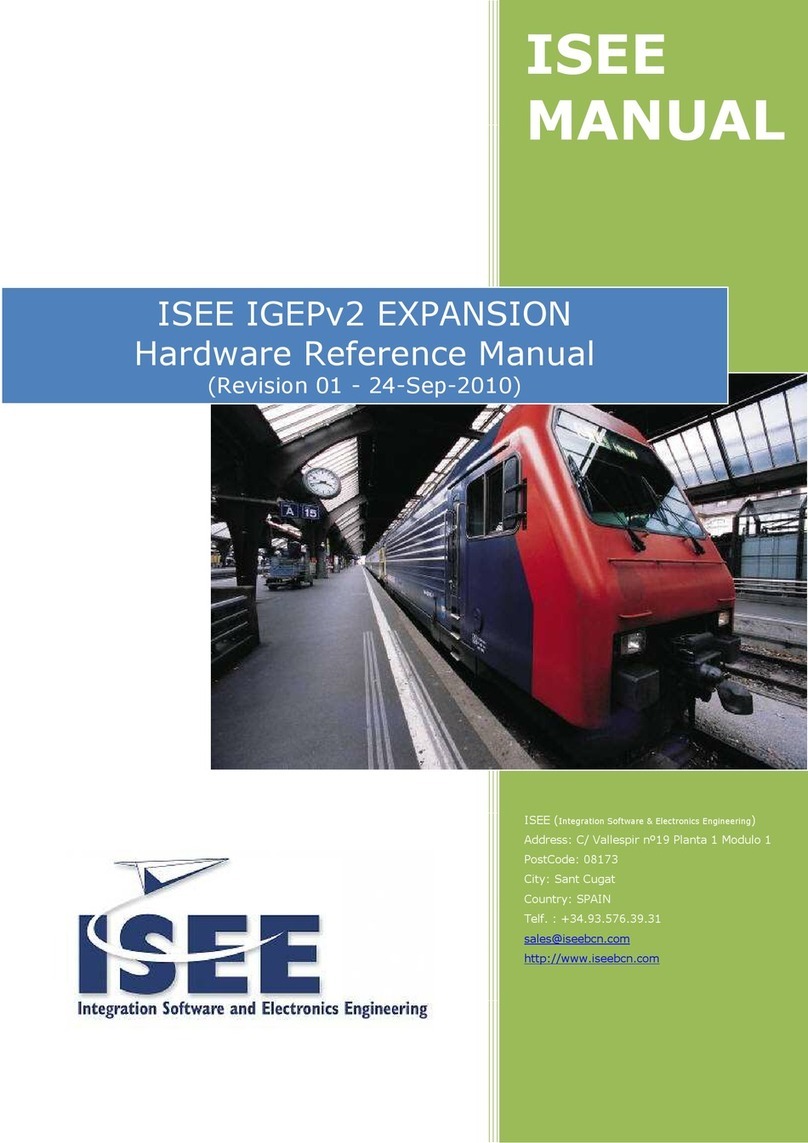
i-See
i-See IGEPv2 BOARD Hardware reference manual

digi-tech
digi-tech RP70 owner's manual

Multitech
Multitech MultiModem ISI ISI5634UPCI Series user guide
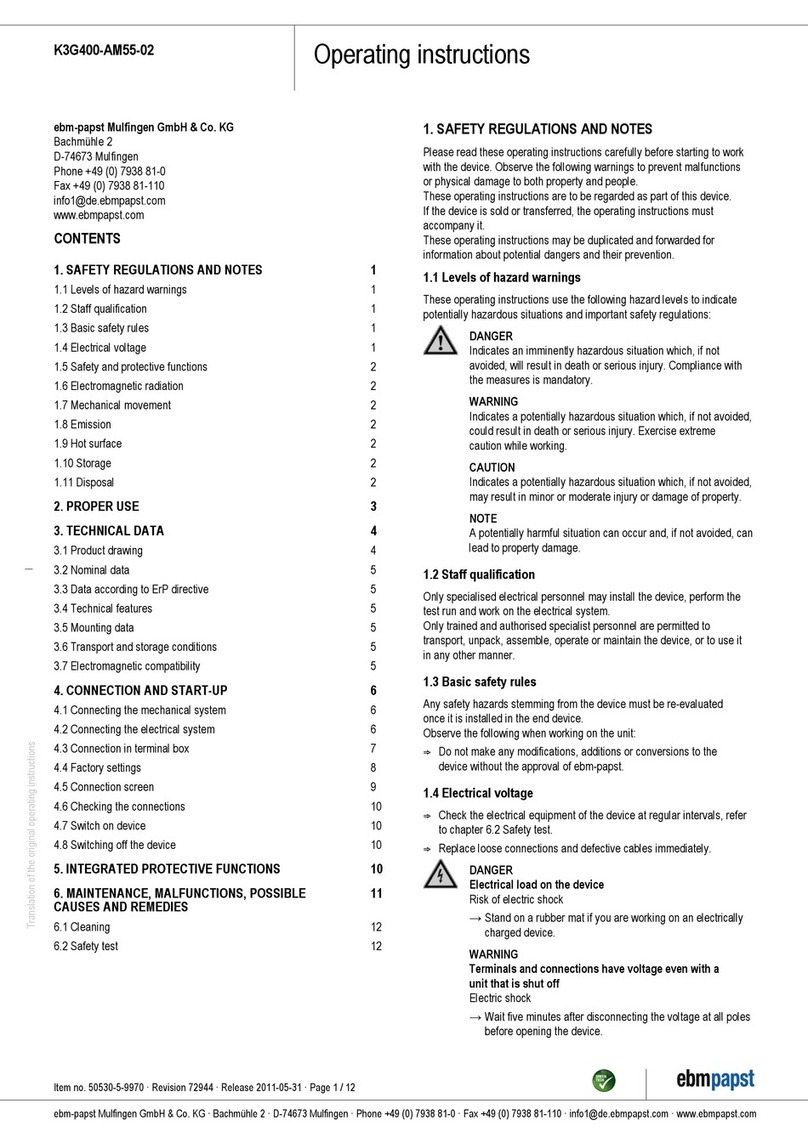
Ebmpapst
Ebmpapst K3G400-AM55-02 operating instructions
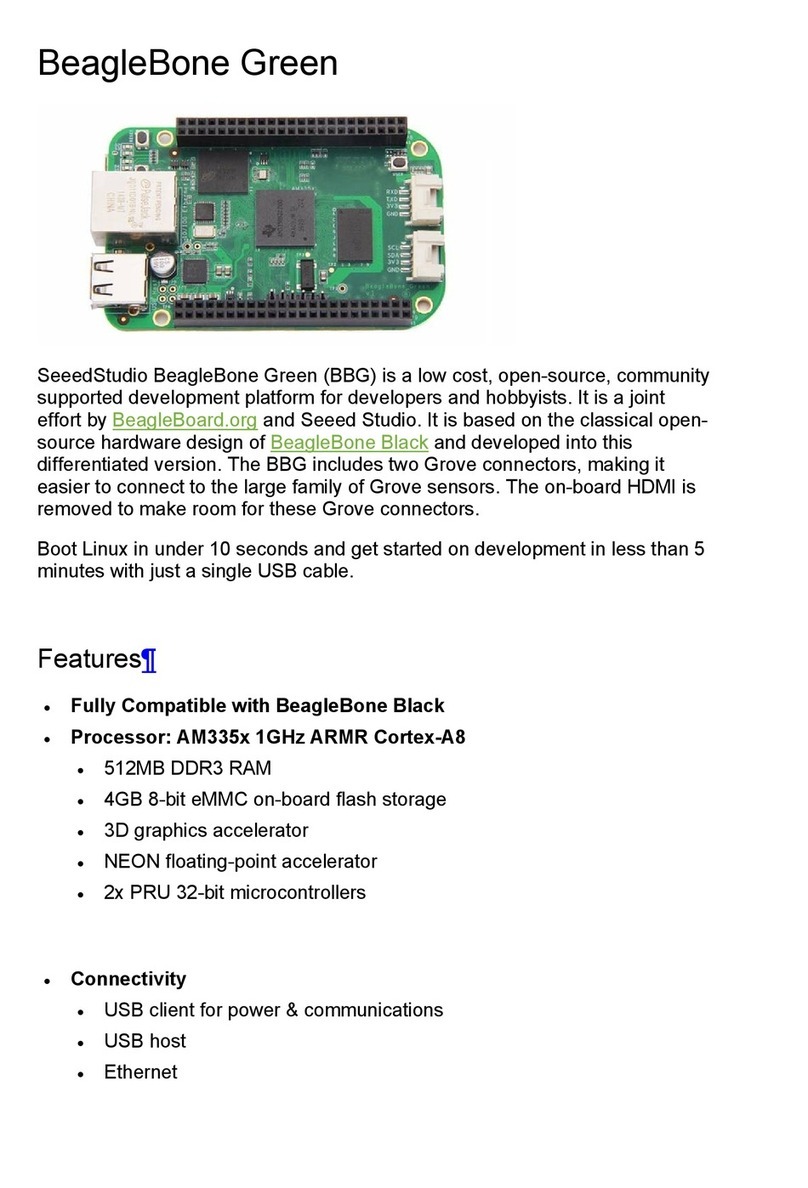
seeed studio
seeed studio BeagleBone Green instruction manual

Step Technica
Step Technica MKY33 user manual
